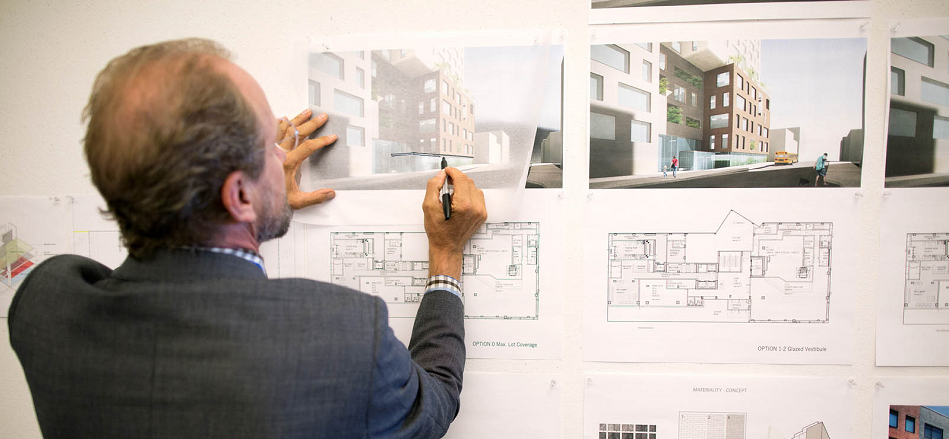Tag archives for: architecture

October 6, 2022 – The post-pandemic job hunt is in full swing, and for architects and interior designers, the demand is higher than the supply. With businesses reopening and new companies starting, there is a greater need for these professionals’ design services. If you are an architect or interior designer looking for a job, now is the time to start your search!
There are a few things that you can do to increase your chances of landing the job that you want. First, ensure that your resume and portfolio are up-to-date and highlight your experience in the industry. Next, reach out to your contacts and let them know you are looking for work. Don’t be afraid to apply for jobs outside your usual area of expertise; sometimes, the best opportunities come from unexpected places. Seek out a salary and compensation package that takes inflation into account. And finally, enlist a qualified placement firm on your behalf to uncover “hidden” openings.
With a little effort, you should be able to find the perfect job in this post-pandemic world. Good luck!
Do you have any tips for job hunting in the current market? Could you share them with us in the comments?
ABOUT THE AUTHOR
After working at various design practices on a full-time and freelance basis and starting his design firm, David McFadden saw a gap to fill in the industry. In 1984, he created an expansive hub for architects and hiring firms to sync up, complete projects, and mutually benefit. That hub was Consulting For Architects Inc., which enabled architects to find meaningful design work while freeing hiring firms from tedious hiring-firing cycles. This departure from the traditional, more rigid style of employer-employee relations was just what the industry needed – flexibility and adaption to current work circumstances. David has successfully advised his clients and staff through the trials and tribulations of four recessions – the early ’80s, the early ’90s, the early 2000s, the Great Recession of 2007, and the Pandemic.
The Job Hunt
|
architects, architecture, Consulting For Architects, David McFadden, demand, design, interiordesigners, jobhunt, jobs, pandemic, post, resume, supply, talent, Talent Shortage, unemployed architects
|

October 6, 2022 – There is no doubt that the architecture and design industry is booming. With new buildings and other projects popping up all over the country, the demand for talent is higher than ever. However, with a large percentage of the workforce leaving the industry during the pandemic, there is a significant gap in the supply of qualified workers.
The shortage has created a fierce hiring war, as companies are fighting to find and retain the best talent. With so many job openings and high demand, architects and designers can be picky about where they work. So, how can you make your firm stand out from the rest?
Here are a few tips:
– Offer competitive salaries and benefits.
– Provide opportunities for career growth.
– Offer a flexible work environment.
– supplement full-time with short-term staff to reduce work hours
– Thoughtfully designed workspace & brand
– Have a strong company culture
By offering competitive salaries, benefits, and opportunities for career growth, you will be able to attract the best talent to your firm. Additionally, having a solid company culture will help you retain that talent. So, make sure you are prepared to fight for the right talent!
ABOUT THE AUTHOR
After working at various design practices on a full-time and freelance basis and starting his design firm, David McFadden saw a gap to fill in the industry. In 1984, he created an expansive hub for architects and hiring firms to sync up, complete projects, and mutually benefit. That hub was Consulting For Architects Inc., which enabled architects to find meaningful design work while freeing hiring firms from tedious hiring-firing cycles. This departure from the traditional, more rigid style of employer-employee relations was just what the industry needed – flexibility and adaption to current work circumstances. David has successfully advised his clients and staff through the trials and tribulations of four recessions – the early ’80s, the early ’90s, the early 2000s, the Great Recession of 2007, and the Pandemic.

December 7, 2021 – Freelancers and Independent Contractors Beware: Build Back Better Vows to Impose the PRO Act Which Threatens Your Livelihood
The freedom to work as a freelancer or independent contractor provides flexibility for households and vibrancy to the American economy. It is tailor-made for architecture and design practices and freelance architects seeking to fill the peaks and valleys standard in architecture practices.
The PRO Act bans Right to Work laws nationwide. Still, it also imposes the same independent contractor/freelancer-destroying policies of California’s AB5 law, which has destroyed countless lives and driven people out of the Golden State.
Freelancers and independent contractors want to be their bosses. AB5 and the PRO Act dictate they must have a boss. Households need greater flexibility than ever after the changes brought about by COVID in the workplace.
I have been fighting my whole professional career for the right to freelance and become an independent contractor. We need to rally the political wing of AIA.org and ask their Advocacy group to engage and lobby against this provision of the Build Back Better bill.
Act Now Contact Sarah Dodge, AIA, Senior Vice-President of Advocacy & Relationships, and ask her to put the full force of the AIA’s advocacy group behind removing the AB5 provision out of Build Back Better!
[email protected]
Partial hat tip to the Freelancers Union
Freelance Community
|
AB5 Law, AIA.org, American Institute of Architects, architects, architecture, architecture practices, Build Back Better, Consulting For Architects, COVID, David McFadden, design, economy, Freelancers, freelancing, Independent Contractors, jobs, Livelihood, Pro Act, Workplace
|

Self-employed workers and independent contractors now qualify for the Pandemic Unemployment Assistance program.
On Monday, Cuomo announced the state would be partnering
with Google to create a new website that would help streamline the application
process for those still seeking to file a claim.
The website was expected to launch last night, but instead,
it launched Friday morning at 7:30.
It can be accessed by going to unemployment.labor.ny.gov.
To sign in, you will need to enter your ny.gov ID information or create a new account.
From there, users will be asked to fill out an application and
submit any required documents through a secure online portal.
If you have problems with your current account or issues
with creating one, you can call 800-833-3000 for assistance.
Anyone who partially completes their application will be
contacted by a service representative within 72 hours.
How does the callback
system work?
After applying, a state representative will reach out within
72 hours to complete your claim.
Those who have filed a claim and were told to call the
unemployment hotline to complete their application should stop calling and wait
to be contacted, according to the Department of Labor.
“Anyone who was already in the process of filing an application, whether by phone or online and was told to call back to complete their claim will not have to call back,” Deanna Cohen, a spokeswoman for the department, said in an email Friday.
A total of 810,000 have filed an unemployment claim as of
Thursday, Melissa DeRosa, Cuomo’s top aide, said.
Around 600,000 of those claims have been fully completed and
another 200,000 are in partial status.
The state is in the process of completing those claims.
A total of 6,000 people have been contacted under the new
call system as of Friday morning, DeRosa said.
I’ve applied using
the old site. Should I do so again?
No.
Claims filed using the old website are still being processed
and anyone who was told to call the state’s unemployment hotline to complete
their application should stop calling.
A representative from the Department of labor will instead
contact you within 72 hours.
What’s the best way
to apply?
The state is urging all those looking to apply for benefits
do so online and wait to be contacted by a representative.
But calls are still be accepted through the state’s unemployment
hotline at 888-209-8124.
To better process claims by phone, the state has started fielding calls seven days a week and has implemented a filing system by the last name.
Hours for the call center are Monday thru Friday: 8 a.m. to 7:30 p.m., and Saturday and Sunday from 7:30 a.m. to 8 p.m.
The filing system by the last name goes as:
A-F: Monday.
G-N: Tuesday.
M-Z: Wednesday.
What do I qualify
for?
A number of unemployment benefits have been extended to
those who normally would not qualify as a result of the federal Coronavirus
Aid, Relief, and Economic Security Act, or CARES Act, a $2.2 trillion stimulus
package approved by Congress last month.
New York provides up to $504 a week for unemployment, based
on a person’s salary.
Self-employed workers and independent contracts now qualify
for the Pandemic Unemployment Assistance program.
But individuals cannot apply for PUA until it is determined
they do not qualify for regular unemployment benefits.
That requires an extra step.
First, a person must file a regular unemployment claim through the state’s Department of Labor.
Once it’s determined they do not qualify, they can then
apply for PUA through the state.
To apply, visit unemployment.labor.ny.gov.
What else do I get
under the CARES Act?
Those who qualify for unemployment benefits will also
receive an additional $600 a week from the federal government through July 31.
In addition, the federal government is in the process of
sending out a one-time stimulus check to nearly all Americans.
Most individuals
COVID-19 Update
|
architects, architecture, cares act, covid19, department of labor, Google, governor cuomo, Independent Contractors, Interior Designers, jobs, new york city, Self Employed, unemployed architects, unemployment, unemployment assitance, unemployment benefits, unemployment insurance
|

In our third installment of Archinect’s Guide to Job Titles series, we attempt to tackle the nuanced role of the Studio Director without falling back on search engines like Google and Bing or job boards like Glassdoor, Indeed, Monster, or Ladders [not in original article]. As with most positions within architecture firms, the lines are quite blurry when it comes to the role of Studio Director. For some, this leadership position acts as a kind of operations specialist and strategist while also functioning as a firmwide design leader. For others, the Studio Director might function as a buffer between design teams and the higher-level leadership of an organization. And for others still, this individual might run their studio as a kind of “mini-firm” within a larger firm, responsible for their own business development, hiring, project management, and overall growth. The intricacies and variations associated with such a dynamic posting can’t be explained exhaustively, there will always be some deviation. Nevertheless, what follows is our attempt to capture the inherent essence of this career path in architecture.
Structural Relevance
Architecture firms come in many forms. Depending on size, the internal structure of the personnel will differ. Some firms might operate in a departmental structure, where each team works on a specific phase of a project: a design “department” might work on the programming and schematic phases before passing the work on to a technical department that would realize the construction documentation. Others might have various project teams, each with its own project managers who are overseen by a Studio Director or Principal(s). And others still might divide into multiple studios, each with a specific function, and led by their own Studio Director, respectively. In this structure, each Studio Director would report to a Managing Principal, Design Principal, or both. Some Studio Directors may even be partners of the firm or Principals themselves. When it comes to the possible organizational structures of design firms, the variations are many.
While the interpretation of the role will differ from office to office, a Studio Director will typically oversee a studio. This may be a single studio under one roof, with a small or medium-sized staff, separated into smaller teams, each with a project architect/project manager, a job captain, and designers. Each team leader could report to a Studio Director who then might report to or collaborate with a higher-level leadership team, such as a firm’s Principal(s).
A studio could also be one of many within a larger firm, each with an expertise focus such as hospitality, healthcare, sports, workplace, restoration, or interiors. Each Studio Director would have specialized knowledge and experience in their area of expertise. In this model, studios might operate under the umbrella of a larger firm but would function as its own “sub-firm,” having its own clients, staff, and sometimes even its own receptionist. These “studio structures” can vary widely, and the nuances will depend on the organization in question.
A Studio Director Needs to be a People Person
In Archinect’s Growing Leadership and Practice: Laney LA’s Search for a Studio Director, we dove deep into conversation with Anthony Laney of Laney LA about his search for a Studio Director. “On day one, five project managers, each with their own team of one to two aspiring architects, will report to the Studio Director,” Laney told Archinect. “So, in total, the Studio Director will be leading a team of about 14 people. Right now, I’m giving about 30 percent of my time to a Studio Director role. We want to tear the lid off of that and allow someone to give it 100 percent of their time.” Here we have the leader of a relatively medium-sized firm in need of a Studio Director to act as a point person between him and his project managers. Laney saw this as someone who was not only in love with design, but who also had a deep passion for creating and building a great team.
People skills are 80 percent of the job, probably more…
Archinect also spoke with Lindsay Green, Principal and Studio Director at OFFICEUNTITLED, and Shawn Gehle, Principal and Co-Founder. On the topic of managing a team and dealing with different kinds of people, the pair elaborated further. “People skills are 80 percent of the job, probably more,” they said. “You have to deal with multiple personalities every day. Happy people; sad people; staff; clients; personal issues amongst the team.” They went on to articulate the expansive role a Studio Director might have within an office. In addition to effectively managing people, a leader in this role might also take on responsibilities of reviewing the office’s backlog and ensuring future staffing needs are fulfilled, overall professional development and client management, internal development of team members, human resources, and finance. “We really rely on Lindsay to run this office, we look to her to understand our overall health and outlook,” Gehle said of Green. “She acts as a kind of Chief Operations Officer, shepherding the resources within the office.”
A Strong Business Acumen
Green’s role goes far beyond that of the traditional project manager or project architect, but rises further into rigorous strategic planning and execution, calling for business acumen and facility not typical in architects. “I think if someone is considering this role as something to work towards in their career, they should consider getting an MBA. Understanding business is crucial in this position,” Green elaborated. “And even after that, it’ll take on-the-job experience to establish an understanding of how firms operate.”
Where before one’s core preoccupation might have been client satisfaction, design quality, timely deliverables, and internal team health, the focus now expands to a broader higher level concentration dealing with the business, strategic, and developmental aspects of the organization as a whole. Yes, project teams are concerned with these aspects, but on a fundamentally different level. They have a responsibility for their projects, whereas a Studio Director’s daily duties directly deal with the trajectory and direction of the bigger picture, moving beyond a partial focus to a comprehensive one.
What are firms looking for?
So what are firms looking for in a Studio Director? Take Gensler, a corporation based around a “collaborative studio leadership model.” Each studio has a specialty and is led by a highly experienced Studio Director, who oversees everything from overall management of the team and projects to the finances and budget. They work closely with staff in both professional development and mentorship as well as hiring in collaboration with HR. Studio Directors at Gensler are responsible for marketing, developing new business, and responding to RFPs, along with several other high-level responsibilities. According to Gensler, those pursuing this role should have a minimum of 15 years of experience and have a proven record in their area of focus. Moreover, Studio Directors at Gensler should possess a comprehensive personal portfolio of work, illustrating their aptitude and understanding of their expertise. Essentially, Studio Directors are leaders of their own small firm within the larger organization that is Gensler.
A Multi-Disciplined Leader
In the end, Studio Directors are multi-disciplined leaders with a depth of experience that allows them to lead a team of professionals of varying experience levels. They operate on multiple fronts, some of which include business functions such as staff development, hiring, strategic planning, finances, as well as traditional functions like QAQC, guiding design quality, and managing clients and projects. The possibilities appear broad and wide-ranging, but we’ve learned that business acumen is crucial, people skills are essential, and a deep understanding of the traditional functions of the architect, indispensable.
Author – Sean Joyner is an architect-trained writer and editor at Archinect. His articles and essays utilize themes in history, philosophy, and psychology to explore lessons for students and professionals within the fields of architecture and design. Sean’s work prior to Archinect focused primarily on k-12 and higher education projects in Southern California. Some of the things Sean enjoys are playing and practicing chess, studying obscure topics like quantum physics and cryptography, working out, and reading compelling books.
Sean Joyner’s Blog on Archinect
Archinect
Consulting For Architects, Inc. Staffing and Recruiting Hiring Trends Blog
Articles:
Salary and responsibilities for design directors for interior design
Harvard GSD announces winners of 2020 Richard Rogers Fellowship
Job Titles
|
Archinect, architecture, architecture jobs, Careers, Consulting For Architects, design, Gensler, Hiring, hiring an architect, hiring firms, ilookup, jobs, mentoring, studio, studio director, teaching, titles
|

Whether you are in architecture or another industry, workers
today are finding advantages to switching jobs periodically rather than
remaining with the same company over a lifetime. From bigger paychecks to
higher positions, the benefits of mobility cannot be understated. However, the
way you move from one job to another speaks volumes about your professionalism
as well as your capacity for working well with others. Consider these five tips
to help you change architect positions without burning bridges.
The Time Factor
Giving notice is usually the first step toward moving up and
on. However, how you handle your notice will make a significant impact on how
your current employer views you once you are gone. While two weeks is the general
rule for resignations, you may need to give time depending on your specific
situation. The primary goal is to make the transition from you to your
replacement as smooth as possible without sticking around long enough to make
people feel awkward. When deviating from the two-week guideline, it is not
usually advisable to change that by more than a week either way.
It’s Not What You Know
You know the adage, “It’s not what you know, but who you
know.” Every architect position you hold gives you the opportunity to build
your professional network. You likely have some potentially valuable
connections at your current company, which may prove beneficial in the future.
Take the time to nurture those relationships before and after you switch
companies and be sure to keep your contact information current in case previous
contacts need to be in touch with you.
You Can’t Take it With You
Some things you should leave behind when you leave your
position, such as company data, clients and fellow employees. Soliciting
clients or employees is not an admirable practice and may be a violation of
your contract. Take steps to separate your personal information from the
company data file to avoid any suspicion of impropriety as you move to your
next architect position. An attitude of transparency will make the difference
in leaving your current employer on good terms.
Tie Up Loose Ends
At the same time, you also want to make sure you don’t leave
any loose ends as you walk out the door. Personal belongings should be taken
home with you as soon as you give notice. CNBC
recommends you transfer benefits like your 401k as well. You also want to arrange
to extend your healthcare benefits if your insurance coverage at your new
company does not become effective right away.
Interview at the End Like You Did at the Beginning
Many companies have an exit interview at the end of an
employee’s tenure. While this might seem like a tempting time to raise concerns
or voice complaints, it is always best to keep this meeting just as
professional and positive as your first interview was with the company. If you
do have issues to bring up, do so in a positive way – in the interest of
creating a better environment for your replacement and others.
Architecture Careers
|
Architect, architecture, architecture career, architecture jobs, architecture profession, Careers, Job Board, job hunting, Job Interviews, Job Search, jobs for architects
|

Female Architects by the Number
Winner of the Emerging Woman Architect of the Year Award 2014, Julia King talks about her work in both the UK and India
While women have forged a path in many male-dominated industries today, challenges still face female architects. As women are slowly moving into relevant positions and even leadership roles, there is still plenty of work to be done. Fortunately, awareness of inequality has been the first step in the creation of organizations and movements to support women passionate about the field. In addition, some outspoken architects are bringing the issue into focus, increasing awareness and encouraging women interested in studying architecture to pursue the profession as a legitimate career path.
While statistics offer hope that the presence of female architects are on the rise, the numbers also show there is more work to be done. According to a 2018 report in Artsy, women comprise approximately half of the students in architecture schools today. However, the numbers begin to decline dramatically as students move to the professional world, with women making up only 18% of licensed architects. Even more concerning is the fact that just three of the top 100 architecture firms are led by women.
When considering global numbers, the statistics start to
lean more in the favor of women in the industry. The National Council of Architectural
Registration Boards (NCARB) estimated in 2016 that women made up more than
one-third (36%) of all newly licensed architects. That number marks a small
increase from 2015, when 34% of new licenses went to women.
Issues Facing Women in the Industry
One of the biggest concerns female architects have today is inequality
when it comes to salary. A 2017 article in the journal Archipreneur
found that men earning $100,000 or more outpace women earning the same amount
by 7%. The difference exists even though more women than men have a four-year degree.
At the lower end of the salary scale, nearly twice as many women as men earn
less than $50,000.
The issues relating to salary inequalities was summed up in
part by a 2018 article in the New
York Times, titled, “Where are all the Female Architects?” The report noted
that pipeline is not a problem as it is in other industries, since plenty of
women are going to school to train for the profession. Instead, a generalized
negative perception of women in the profession could be at the root of the
difference. The New York Times reports that as recently as 2018, there were
assumptions that women would quit if they got married or had children, or that
they would not be able to lead with authority on job sites. Even their
creativity has been questioned at times in this male-dominated industry.
Growing Support Network
Fortunately, more women are becoming known in the industry
today, paving the way for other female architects to join the ranks. The New
York Times also reports that more women are getting appointed as deans or
directors at architecture programs at prestigious schools like Cornell,
Columbia, Princeton, and Yale. Female architects at the top of companies are
also gaining more recognition as trade journals and mainstream media are
highlighting these women.
Industry organizations are also beginning to make a place
for women – through conferences geared specifically to female architects or committees
designed to bring women in the profession together. The American
Institute of Architects (AIA) is hosting its first Women’s Leadership
Summit in September of this year, in an effort to bring together female
architects and those that have achieved leadership roles within their
organizations.
According to the AIA website, the goals of the Women’s
Leadership Summit are:
- Increase awareness of women in the industry
- Create a learning environment by combining women
at various stages of their careers
- Help women discover paths to leadership roles
- Provide the opportunity for women to learn from
one another
In addition, the AIA New York features a Women in
Architecture Committee to develop and promote women in the industry through
monthly meetings and other events. The local committee focuses on licensure,
mentorship and networking opportunities to help women take their careers in
architecture to the next level.
Pioneers Taking the “Female” Out of the Position
As more women take the stage in the architectural industry,
women following in their footsteps can find both inspiration and knowledge to
succeed in their careers. Dorte Mandrup, a Danish architect who is also the
creative director and founder at Dorte Mandrup, published an article in 2017,
which appeared in Politiken and Dezeen.
In the article, Mandrup makes the point that she does not
want to be referred to as a “female architect.” Instead, she wants to be known
as an architect – one whose work can compare with the creativity of any male
without having the additional label attached. She believes that until women
stop getting referred to as “female architects,” true equality within the
industry cannot happen.
Liz Ogbu trained as an architect at the Harvard Graduate
School of Design. However, she referred to herself in the New York Times
article as a “designer, social innovator, and urbanist.” Her point was that
women can make a name for themselves in the world of architecture to redefine success
within the industry. Instead of focusing solely on skyscrapers and museums, Ogbu
is focusing on designs for the underprivileged such as shelters for immigrant
day workers.
“In many ways, architecture is a profession that has been the
epitome of the dominant white patriarchy, from most of the celebrated
starchitects to the all too frequent obsession with buildings that are better
known for their beauty of the object rather than the quality of the life that
they enable…I’ve been committed to a design practice that is rooted in
elevating the stories of those who have most often been neglected or silenced.”
Whether you are looking for your very first position in the industry or
ready to take your career to the next level, we can help. We help architects,
interior designers and others in the building design profession find the job of
their dreams. Contact CFA
today to learn more.
Women in Architecture
|
aia awards, AIA Billing Index, aia firm survey, archipreneur, architecture, Architecture billings index, architecture careers, architecture programs, Compensation, cornell, David McFadden, deans, dorte mandrup, equal pay, femail architects, google blogs, harvard, ilookup, Job Search, julia king, leadership roles, learning environment, liz ogbu, maledominatedindustry, meninarchitecture, metorship, princeton, promote women, salary ineqquality, starchatect, trade jourmals, winneremergingwomanarchitect, women, women in architecture, Women in Architecture Committee, Women's Month, womensleadershipsummit, yale
|

Successful architecture careers don’t happen by accident. Just like well-designed buildings, they’re the result of careful planning.
While there are countless metrics you can consider when going about this planning, one of the most important is the city within which you’ll work.
That’s why we’ve put together a list of the three best cities in the country for professionals who are serious about pursuing successful architecture careers.
We based this list on the all-important factor of salary but also on other unique traits worth considering.
1. Atlanta, Georgia
Georgia is one of the best states for architects, so it should come as no surprise that many point to its capital as the best city for this profession.
Even though Atlanta is home to countless high-paying careers, architects are among the top 50 best-paid. Architectural managers even crack the top 20, alongside lawyers, several doctors, and even physicists.
Of course, Atlanta also has an impressive history of hosting incredible buildings from a number of different styles, so you won’t be lacking for inspiration. That said, you won’t be lacking for competition, either. Atlanta is home to a few award-winning architects, though that also means plenty of impressive firms looking for new talent.
2. West Palm Beach, Florida
Located about an hour-and-a-half north of Miami, West Palm Beach has plenty going for it aside from the incredible weather. On average, the highest-paid architects in the country call West Palm Beach home. That average salary is an impressive $120,380 a year. Florida does not have a State income tax either.
The city is also full of architecture firms – well over three dozen of them – so you shouldn’t have too much trouble beginning your job search.
Many world-class architects choose West Palm Beach for their headquarters because there is no lack of developers with large budgets who appreciate beautiful designs.
The city also attracts talent from across the world for the same reason. As just one example, look no further than the $100-million expansion of the Norton Museum, which was designed by Norman Foster, a winner of the Pritzker Architecture Prize.
3. Chicago, Illinois
For our third spot on the list, we head north to the Windy City. Chicago’s history as a city of architectural wonders probably began in 1893 during the World’s Fair. It debuted the first ever Ferris Wheel but also brought in some of the time’s most prominent architects to contribute their talents.
Though only one major structure survived, Chicago’s tradition of welcoming incredible architects has carried on. Over the years, famous architects like William Le Baron Jenney and Frank Lloyd Wright have all left their mark on Chicago.
Modern architects looking to do the same won’t be disappointed. While the pay isn’t as much here, the cost of living is also much lower, meaning your salary will stretch a lot further.
Work with Experts Who Specialize in Launching Architecture Careers
Want more help getting your career off the ground?
At Consulting For Architects, we specialize in both project placement and permanent placement for professionals who are dedicated to pursuing successful architecture careers. If you’d like the help of an experienced team of experts, please feel free to contact us today.

No matter what you hope your destination will be, if you want to make a career out of architecture, it’s going to start with an entry-level job.
While that may not seem quite as exciting as your long-term goal, entry-level architecture jobs have a lot of potential if you know exactly how to approach them.
4 Ways to Make the Most Out of Entry-Level Architecture Jobs
Finding out you’ve been hired for your first architecture job is an absolutely incredible feeling.
However, don’t forget about the following four ways people have successfully taken full advantage of their entry level-architecture jobs, so you can make the most of this opportunity.
1. Consider the City the Job Is In
If you’re still applying for jobs, be sure to consider which city those jobs are in. Ideally, you want it to be a great city for architects, so you’ll be surrounded by opportunities.
That said, no matter where it is, brush up on your networking skills. This will help you on the job (more on that in a minute), but it will also go a long way toward helping you eventually find an even better role if you use these skills within your local industry.
2. Firm Up Your Soft Skills
Your duties as an architect include more than just preparing drawings and structure specifications.
Success will also depend on your soft skills, which include proficiency with:
- Team-building
- Communicating
- Problem-solving
Look for every opportunity in your entry-level role to sharpen these skills and the road ahead of you will become much easier.
3. Come Up with a 90-Day Plan
Every entry-level employee should come up with a 90-day plan to hit the ground running. This is especially true in architecture, though. You should also have a plan for the first week and the first month.
For example, during your first week, meet everyone on your team, department, or inside the entire firm, depending on its size. Become 100% clear on what your responsibilities are, too.
Over the first 30 days, finish meeting everyone if you haven’t already. Make it a point to ask at least one question a day, provided you genuinely don’t know the answer and you’re not slowing down your coworkers. It’s vital that you learn as much as possible.
During the first 90 days, you should look for a “mentor.” This doesn’t have to be an official capacity, but get a sense for whom – aside from your boss – you can learn the most from and keep asking them questions.
Of course, if they ever need help, go out of your way to repay their kindness.
Want Help Finding the Best Entry-Level Architecture Jobs?
As you can see, entry-level architecture jobs can be so much more than just an opportunity to get your foot in the door.
When you take the right approach, they can become a real launching point for the rest of your career. You may even be surprised to find just how quickly the above advice can bring you to your next step.
Of course, long before that happens, you need to land that first position. That’s where we come in. At Consulting For Architects, Inc. we’ve helped people just like you land their first jobs. Contact us today and let’s talk about how we can help you with your specific goals.

Congratulations on your recent graduation.
It probably feels pretty amazing to have that degree.
Of course, the longer you go without using it, the more that degree is going to become an irritating reminder. So, let’s look at four of the best architecture careers you can start pursuing right away.
The 4 Best Architecture Related Careers to Get Started in Right Now
The field of architecture is at least as broad as it is old. As such, it’s probably fair to say that there are countless architecture careers out there for you to consider.
However, the following four fields will give you plenty of diverse options beyond the traditional versions. Best of all, each features plenty of job openings throughout the country.
- Landscape Architect
Landscape architects are responsible for planning and creating landscapes, which can include manmade features, as well. Oftentimes, landscape architects need to collaborate with others, so that their creations complement buildings that will share the same environment (and vice versa).
This career may also involve the long-term care of the landscape, as well. This is when a talent for the natural sciences is very helpful.
- Urban Planner
While urban planners and architects are not the same thing, the former relies on the latter. In fact, many architects make a career out of leveraging their skills specifically to help with urban planning.
As a huge part of this field involves the buildings in urban environments, it requires an architect who’s able to take the resources available (including money and space) and make the most of them. An architect who becomes proficient at this will never be long without work.
- Architecture Journalist
Architecture is such a massive industry that it requires an equally impressive army of journalists. Unfortunately, most journalists don’t have a very good understanding of architecture. They might be able to cover the topic for those outside the industry, but their lack of knowledge wouldn’t go unnoticed by those who depend on a high-level expertise for a living.
If you understand everything from the vocabulary unique to architects to its history and current trends, you’ll be a priceless asset as a journalist for this industry.
- Architectural Historian
Finally, if you have a passion for history and architecture, you will be uniquely qualified to become an architectural historian.
In short, as an architectural historian, your job will involve advising restoration projects aimed at buildings of historical significance. This often involves researching the building to better understand the materials and methods that were used to build it.
Want an Expert’s Help Considering Architecture Careers?
While we hope that the above list of possible architecture careers is helpful, we know that this decision is a big one and you may want some help with it.
At Consulting For Architects, Inc. Careers we’ve helped recent graduates just like you with this important next step, ensuring that they find jobs which fall in line with their interests and career goals. Contact us today at (212) 532-4360 or [email protected] to learn more about how we can help you do the exact same thing.
Job Search Mobil App
Enter for a chance to win an iPhone 8!
















